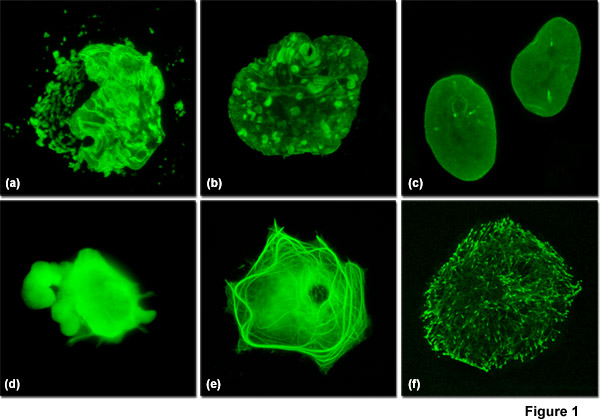SO WHY IS GFP THE BEST?
- Well, GFPs are these awesome green colored proteins...
And...
- They have been successfully engaged in virtually EVERY biological field, from microbiology to human physiology.
- These ubiquitous markers are extremely useful as reporters for gene expressions in cultured cells, excised tissues, and whole animals.
- In live cells, GFPs are mostly used to track the localization and dynamics of proteins, organelles, and other cellular compartments.
- They can also be used to assess protein-protein interactions through the use of "resonance energy transfer techniques (FRET )."
- The application of GFPs consists of fusing the gene for the cDNA of the target gene to that of a GFP followed by transferring the resulting recombinant vector into a host cell or whole organism.
- "Light is produced by the bioluminescent jellyfish Aequorea victoria when calcium binds to the photoprotein aequorin. This jellyfish produces green lights. This light is the result of a second protein in A. victoria that derives its excitation energy from aequorin, the green fluorescent protein." (http://pubs.acs.org/doi/pdf/10.1021/bi00056a003)
- "Purified GFP, a protein of 238 amino acids, absorbs blue light (maximally at 395 nm with a minor peak at 470 nm) and emits green light (peak emission at 509 nm with a shoulder at 540 nm)" (http://pubs.acs.org/doi/pdf/10.1021/bi00056a003)
- It provides an excellent means for monitoring gene expression and protein localization in living cells.
- Because it does not appear to interfere with cell growth and function, GFPs are also a convenient indicator of transformation and one that allow normal cells to be separated with fluorescence-activated cell.
- GFP can be used as a vital marker so that cell growth and movement can be followed, especially in animals that are essentially transparent like C. elegans and zebra fish.
- The relatively small size of the protein my facilitate its diffusion throughout the cytoplasm of extensively branched cells like neurons and glia.
 |
| http://zeiss-campus.magnet.fsu.edu/articles/probes/fpconsiderations.html |
 |
| Pymol; protein data bank 1S6Z |
 |
| Pymol; protein data bank 1S6Z |
 |
| Pymol; protein data bank 1S6Z |
- GFP has jumped from being insignificant to becoming one of the most widely studied and used proteins in biochemistry and cell biology.
- It is very fascinating and amazing to observe GFP's ability to emit an internal flurophore
- GFP has a high resolution structure that helps to understand the relation between protein structure and spectroscopic function.
- GFP is used extensively in observing protein interaction and gene expression in intact cells and organisms
- GFP are also used to find out the behaviors of cancerous cells, which is a huge contribution to the field of oncology in the discovery of new type of cancers.
I'm sure you're convinced by now that GFPs are the best :)
References
http://zeiss-campus.magnet.fsu.edu/articles/probes/fpconsiderations.html
http://www.ncbi.nlm.nih.gov/pubmed/9759496
http://www.tsienlab.ucsd.edu/Publications/Ormo%201996%20Science%20-
%20Crystal%20structure.PDF
http://119.93.223.179/ScienceDirect/Current%20Biology/06-02/sdarticle_022.pdf
http://pubs.acs.org/doi/pdf/10.1021/bi00056a003